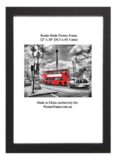Beginning only 20-odd years ago or so, the advent of the internet, while creating new industries and new jobs, also  destroyed comparatively more industries and jobs than it created. This post "Who or what, killed all the picture framing shops? attempts to shed some light on this modern phenomenon. Back then, online sales for picture frames or photo frame didn’t exist, now these are a majority, and are increasing all the time. Again, during this time, picture frames stores and picture framing shop have decreased dramatically, both here in Australia and in the United States.
destroyed comparatively more industries and jobs than it created. This post "Who or what, killed all the picture framing shops? attempts to shed some light on this modern phenomenon. Back then, online sales for picture frames or photo frame didn’t exist, now these are a majority, and are increasing all the time. Again, during this time, picture frames stores and picture framing shop have decreased dramatically, both here in Australia and in the United States.
Taking a look across the Pacific, at the U.S. with about 15 times our population, latest statistics tell us that there are only about 7,000 shops left, or around 75% less than at the 1980’s peak. Australia paints a similar, if not worse, picture.
With devastating figures as these, picture framing shop proprietors, when asked, will nearly always blame the internet as the leading cause of their failing and failing industry However while there’s more than a kernel of truth in statement and sales have definitely increased to buying anything and everything online from food to housing there’s also a plausible argument for other market drivers.
These contributing factors are embedded within and without the picture framing industry itself. Perhaps the most powerful reason for this decline was the evolution and popularization of film photography to digital photography. Film photography cost people money. You had to buy a roll of film, load it, shoot pictures, unload it, take it to the Chemist or nearest file development laboratory and pay some more money to have your stills developed.
And then you could never use the whole lot, most of them would have been of poor quality which you discarded and maybe kept only half a dozen or so. Your iPhone or Samsung with inbuilt digital camera now lets you perform all of these functions and steps, essentially for free. This financial freedom also greatly increased the number of images available for each person. Instead of 24, 36 or 48 images x roll of film, digital cameras allow people to take an essentially unlimited number of photos, or limited to the thousand or so that you can store in you digital camera.
These thousands of images can be stored for free for later viewing, editing , printed and electronic distribution, which costs close to nothing. This digital cornu copia also perversely prostituted the value of images, from something limited, expensive and worth putting into photo frames, to a casual everyday occurrence that can be easily disposed of . A lesser, but related contributor, of this custom picture framing malaise was the invention of digital picture frames.
These devices allowed anyone to easily download digital photos and pictures to the device’s LCD display which could be set to change and rotate as one wished. With these handy and easy electronic capability available, less and less people wanted picture frames made, or went to shops to buy them
Thankfully ( for picture framers that is ) this invention seems to be going the way of the CD and appears to be in its death throes. Another important contributor to the custom picture framing moribundity was the do-your-own printing capabilities afforded by both computers and the internet as a whole. Simply put, people would download the images they took form their phones to their PCs, manipulate these and print them not to an odd or custom size, but to a common,ready-made sizes such as 4”x6”, 5”x7”, 8”x10”, 11”x14”, etcetera.
And we all know that these size photographs can easily and cheaply be framed because every supermarket, chemist and 2-Dollar shops stocks these size for literally a few dollars. These standard size photo frames, picture frames and photo frames are predominantly mass-produced with automated machinery in overseas, low labour cost nations. A labourer in Shandong province, China, earns less than AUD2 x hour, whereas its Australian counterpart earns about AUD22.
Obviously then, Australian photo frame factories and custom picture framing stores are doomed for closure. The other factor is industrial productivity. Asian workers, with their different cultural upbringing, social milieu and economic motivation are simply much , far more productive. Bulk-produced photo frames and picture frames are much cheaper and less expensive to make than custom picture frames. These are also sold at a lower profit margin made possible by the high volume manufactured to maintain owners’ investment profitability.
This low-profit, high-volume manufacturing, buying and selling industrial model in turn is the cornerstone of overseas suppliers and their big department stores customers. And naturally enough, every photo frame, picture frame and poster frame sold by the big store is one less made and sold by your local, suburban shopping strip picture framer. And the last factor, we think, has to do with the innate, conservative, non-entrepreneurial mindset and outlook of most, local street picture framing shop owners.
By and large these one-shop proprietors put most of their time, energies and efforts in the decorative and artistic side of their businesses. They would attend picture framing conventions not to research picture framing pricing software or computerized mat-cutters. They would instead flock to seminars extolling beautiful but expensive decorative techniques such as mat carving or French washlines. Whole groups would attentively listen to picture framing experts encouraging them to add-value to their work so that they could charge customer more and more.
While listening entranced to these well-meaning but non-business experts, the world wide web inexorably progressed forcing whole industries not to increase prices for goods, but to lower them. And picture framers, bless their communal souls, had it so good for so long, that they never saw w.w.w. coming. And they all, slowly died. Requiescat in pace, amen. Thank you for reading our post "Who or what, killed all the picture framing shops?."









While most, if not all of the above may well be true, the real cause night be our declining discretionary spending, if not our living standards as a whole. The housing boom as artificially pushed our houses to such high values and prices that home buyers simply have to sign up for enormous mortgages if they ever want to own a home. And when you and your wife ( or partner ) have a huge mortgage, are you going to spend $300 to have you wedding photo custom framed at your local picture framer? No you won’t. What you’ll do is go to a department store, or that big office place, buy yourselves a cheap A2 Chinese ready-made for $15 and stick the photo in yourselves. And when you get too many people doing that, as it’s happening now, you can kiss your local picture framer store goodbye.
Progress killed all the Australian picture framing shops, the same way it killed Australian-made washing machines, fridges, vacuum cleaners and cars. Overseas workers are as good, as fast and as capable as any workers here. In Shandong, China, you can hire a picture framer for AUD1.25 an hour whereas one here costs AUD25 x hour. More to the point, in China you can hire and fire at the blink of an eye. Here instead, you have to consult an accountant and lawyer, just to do the same. No wonder picture framing manufacturers are shutting down factories here and re-starting them in China, or Vietnam, or Bangla Desh.
I’d like to know to what extent the coronavirus has effected turnover in picture framing shops. our turnover fell very heavily to start with but is now recovering quite well.
Interestingly both our online picture frames and custom picture framing orders increased as well, especially for online sales. The fact that we do sell cheap photo frames and cheap poster frames greatly helps our sales. However we think that the main reason behind the sales surge is the fact that more and more Customers stayed at home instead of going out. And when folks stay at home and have to keep looking at the same decor they’ve probably looked at for years, they decide to do something about it. More often than not they order a new $13, cheapie A2 poster frame, rather than a $120, A2 custom frame, but hey, work is work, so we sell as much as we can, for now. However, when life re-boots after social distancing and Jobkeeper subsidies end, the feeling is that picture frames sales of all types will decrease dramatically. This is because there will be less full-time jobs, work casualization will increase, wages will decrease or stay flat and all discretionary spending will concomitantly fall.